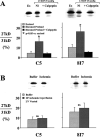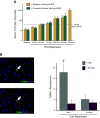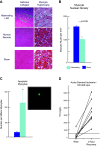Myocardial injury, troponin release, and cardiomyocyte death in brief ischemia, failure, and ventricular remodeling
- PMID: 35559722
- PMCID: PMC9169835
- DOI: 10.1152/ajpheart.00093.2022
Myocardial injury, troponin release, and cardiomyocyte death in brief ischemia, failure, and ventricular remodeling
Abstract
Troponin released from irreversibly injured myocytes is the gold standard biomarker for the rapid identification of an acute coronary syndrome. In acute myocardial infarction, necrotic cell death is characterized by sarcolemmal disruption in response to a critical level of energy depletion after more than 15 min of ischemia. Although troponin I and T are highly specific for cardiomyocyte death, high-sensitivity assays have demonstrated that measurable circulating levels of troponin are present in many normal subjects. In addition, transient as well as chronic elevations have been demonstrated in many disease states not clearly associated with myocardial ischemia. The latter observations have given rise to the clinical concept of myocardial injury. This review will summarize evidence supporting the notion that circulating troponin levels parallel the extent of myocyte apoptosis in normal ventricular remodeling and in pathophysiological conditions not associated with infarction or necrosis. It will review the evidence that myocyte apoptosis can be accelerated by diastolic strain from elevated ventricular preload and systolic strain from dyskinesis after brief episodes of ischemia too short to cause a critical level of myocyte energy depletion. We then show how chronic, low rates of myocyte apoptosis from endogenous myocyte turnover, repetitive ischemia, or repetitive elevations in left ventricular diastolic pressure can lead to significant myocyte loss in the absence of neurohormonal stimulation. Finally, we posit that the differential response to strain-induced injury in heart failure may determine whether progressive myocyte loss and heart failure with reduced ejection fraction or interstitial fibrosis and heart failure with preserved ejection fraction become the heart failure phenotype.
Keywords: HFpEF; HFrEF; apoptosis; ischemia; troponin.
Conflict of interest statement
No conflicts of interest, financial or otherwise, are declared by the author.
Figures









Similar articles
-
Troponin Release and Reversible Left Ventricular Dysfunction After Transient Pressure Overload.J Am Coll Cardiol. 2018 Jun 26;71(25):2906-2916. doi: 10.1016/j.jacc.2018.04.029. J Am Coll Cardiol. 2018. PMID: 29929614 Free PMC article.
-
Episodes of acute heart failure syndrome are associated with increased levels of troponin and extracellular matrix markers.Circ Heart Fail. 2010 Jan;3(1):44-50. doi: 10.1161/CIRCHEARTFAILURE.108.844324. Epub 2009 Oct 22. Circ Heart Fail. 2010. PMID: 19850700
-
Etiology-Dependent Impairment of Diastolic Cardiomyocyte Calcium Homeostasis in Heart Failure With Preserved Ejection Fraction.J Am Coll Cardiol. 2021 Feb 2;77(4):405-419. doi: 10.1016/j.jacc.2020.11.044. J Am Coll Cardiol. 2021. PMID: 33509397 Free PMC article.
-
Clinical aspects of left ventricular diastolic function assessed by Doppler echocardiography following acute myocardial infarction.Dan Med Bull. 2001 Nov;48(4):199-210. Dan Med Bull. 2001. PMID: 11767125 Review.
-
A novel paradigm for heart failure with preserved ejection fraction: comorbidities drive myocardial dysfunction and remodeling through coronary microvascular endothelial inflammation.J Am Coll Cardiol. 2013 Jul 23;62(4):263-71. doi: 10.1016/j.jacc.2013.02.092. Epub 2013 May 15. J Am Coll Cardiol. 2013. PMID: 23684677 Review.
Cited by
-
CLU, FOS, and CXCL8 as diagnostic biomarkers for heart failure progression post-acute myocardial infarction: an integrated RNA-Seq and multi-machine learning study.Front Cardiovasc Med. 2025 Jun 30;12:1611668. doi: 10.3389/fcvm.2025.1611668. eCollection 2025. Front Cardiovasc Med. 2025. PMID: 40662135 Free PMC article.
-
Effects of tirzepatide on circulatory overload and end-organ damage in heart failure with preserved ejection fraction and obesity: a secondary analysis of the SUMMIT trial.Nat Med. 2025 Feb;31(2):544-551. doi: 10.1038/s41591-024-03374-z. Epub 2024 Nov 17. Nat Med. 2025. PMID: 39551891 Free PMC article. Clinical Trial.
-
Uric acid-induced cardiomyocytic polyamines' insufficience: a potential mechanism mediates cardiomyocytic injury.Front Endocrinol (Lausanne). 2025 Apr 7;16:1504614. doi: 10.3389/fendo.2025.1504614. eCollection 2025. Front Endocrinol (Lausanne). 2025. PMID: 40260285 Free PMC article.
-
Remodeling of Cardiomyocytes: Study of Morphological Cellular Changes Preceding Symptomatic Ischemic Heart Failure.Int J Mol Sci. 2023 Sep 26;24(19):14557. doi: 10.3390/ijms241914557. Int J Mol Sci. 2023. PMID: 37834000 Free PMC article.
-
Association of Metabolic Diseases and Moderate Fat Intake with Myocardial Infarction Risk.Nutrients. 2024 Dec 11;16(24):4273. doi: 10.3390/nu16244273. Nutrients. 2024. PMID: 39770895 Free PMC article.
References
-
- Olivetti G, Quaini F, Sala R, Lagrasta C, Corradi D, Bonacina E, Gambert SR, Cigola E, Anversa P. Acute myocardial infarction in humans is associated with activation of programmed myocyte cell death in the surviving portion of the heart. J Mol Cell Cardiol 28: 2005–2016, 1996. doi:10.1006/jmcc.1996.0193. - DOI - PubMed
-
- Jennings RB, Reimer KA, Hill ML, Mayer SE. Total ischemia in dog hearts, in vitro 1. Comparison of high energy phosphate production, utilization, and depletion, and of adenine nucleotide catabolism in total ischemia in vitro vs. severe ischemia in vivo. Circ Res 49: 892–900, 1981. doi:10.1161/01.res.49.4.892. - DOI - PubMed
Publication types
MeSH terms
Substances
Grants and funding
LinkOut - more resources
Full Text Sources
Medical

